Quantifying the Widths of Fault Damage Zones Based on the Fault Likelihood: A Case Study of Faults in the Fuji Syncline of the Luzhou Block, Sichuan Basin, China
Abstract
:1. Introduction
2. Basic Structures of FDZs
3. Materials and Methods
3.1. Principle of Fault Likelihood
3.2. Attribute Results
4. Discussion
4.1. FDZ Widths of Faults in the Fuji Syncline of the Luzhou Block
4.2. FDZ Widths Correlation with Fault Throws
5. Conclusions
Author Contributions
Funding
Institutional Review Board Statement
Informed Consent Statement
Data Availability Statement
Conflicts of Interest
References
- Aydin, A. Fractures, faults, and hydrocarbon entrapment, migration and flow. Mar. Petrol. Geol. 2000, 17, 797–814. [Google Scholar] [CrossRef]
- Wang, R.Y.; Ding, W.L.; Zhang, Y.Q.; Wang, Z.; Wang, X.H.; He, J.H.; Dai, P. Analysis of developmental characteristics and dominant factors of fractures in Lower Cambrian marine shale reservoirs: A case study of Niutitang formation in Cen’gong block, southern China. J. Petrol. Sci. Eng. 2016, 138, 31–49. [Google Scholar] [CrossRef]
- Zeng, L.B.; Lyu, W.Y.; Li, J.; Zhu, L.F.; Weng, J.Q.; Yue, F.; Zu, K.W. Natural fractures and their influence on shale gas enrichment in Sichuan Basin, China. J. Nat. Gas Sci. Eng. 2016, 30, 1–9. [Google Scholar] [CrossRef]
- Choi, J.H.; Edwards, P.; Ko, K.; Kim, Y.S. Definition and classification of fault damage zones: A review and a new methodological approach. Earth-Sci. Rev. 2016, 152, 70–87. [Google Scholar] [CrossRef]
- Espejel, R.L.; Alves, T.M.; Blenkinsop, T.G. Multi-scale fracture network characterisation on carbonate platforms. J. Struct. Geol. 2020, 140, 104160. [Google Scholar] [CrossRef]
- Fossen, H.; Schultz, R.A.; Shipton, Z.; Mair, K. Deformation bands in sandstone. J. Geol. Soci. 2007, 164, 755–769. [Google Scholar] [CrossRef] [Green Version]
- Hansberry, R.L.; King, R.C.; Holford, S.P.; Hand, M.; Debenham, N. How wide is a fault damage zone? Using network topology to examine how fault-damage zones overprint regional fracture networks. J. Struct. Geol. 2021, 146, 104327. [Google Scholar] [CrossRef]
- Kim, I.; Park, S.; Kwon, S.; Lee, H. Evolution of fracture networks and connectivity during fault–bend folding: Insights from the Sinon Anticline in the southwestern Hongseong—Imjingang Belt, Korea. J. Struct. Geol. 2022, 155, 104506. [Google Scholar] [CrossRef]
- Brogi, A. Fault zone architecture and permeability features in siliceous sedimentary rocks: Insights from the Rapolano geothermal area (Northern Apennines, Italy). J. Struct. Geol. 2008, 30, 237–256. [Google Scholar] [CrossRef]
- Cello, G.; Tondi, E.; Micarelli, L.; Invernizzi, C. Fault zone fabrics and geofluid properties as indicators of rock deformation modes. J. Geodyn. 2001, 32, 543–565. [Google Scholar] [CrossRef]
- Saul, C.J.; Evans, J.P.; Forster, C.B. Fault zone architecture and permeability structure. Geology 1996, 24, 1025–1028. [Google Scholar]
- Anita, T.; Silje, S.B. Scaling of fault attributes: A review. Mar. Petrol. Geol. 2011, 28, 1444–1460. [Google Scholar]
- Shang, F.H.; Zhu, Y.M.; Gao, H.T.; Wang, Y. Analysis of Developmental Characteristics and Dominant Factors of Pore-Fracture Systems in Lower Cambrian Marine Shale Reservoirs: A Case Study of the Niutitang Formation, Fenggang Block, Southern China. J. Nanosci. Nanotechnol. 2021, 21, 57–71. [Google Scholar] [CrossRef] [PubMed]
- Wang, G.; Carr, T.R. Organic-rich marcellus shale lithofacies modeling and distribution pattern analysis in the appalachian basin. AAPG Bull. 2013, 97, 2173–2205. [Google Scholar] [CrossRef] [Green Version]
- Gao, D.L.; Duan, T.Z.; Wang, Z.G. Caledonian detachment deformation and deposition in the fuling gas field of the southeastern Sichuan Basin in China: Implications for the Lower Silurian Longmaxi shale gas exploration and production. Interpretation 2018, 6, SN119–SN132. (In Chinese) [Google Scholar] [CrossRef]
- Li, Y.Z.; Wang, X.Z.; Wu, B.; Li, G.; Wang, D. Sedimentary facies of marine shale gas formations in southern China: The lower Silurian Longmaxi formation in the southern Sichuan Basin. J. Earth Sci. 2016, 27, 807–822. (In Chinese) [Google Scholar] [CrossRef]
- Ma, X.H.; Xie, J.; Yong, R.; Zhu, Y. Geological characteristics and high production control factors of shale gas reservoirs in Silurian Longmaxi Formation, southern Sichuan Basin, SW China. Pet. Explor. Dev. 2020, 47, 841–855. (In Chinese) [Google Scholar] [CrossRef]
- Nie, H.K.; He, Z.L.; Wang, R.Y.; Zhang, G.; Chen, Q.; Li, D.; Lu, Z.; Sun, C. Temperature and origin of fluid inclusions in shale veins of Wufeng—Longmaxi Formations, Sichuan Basin, south China: Implications for shale gas preservation and enrichment. J. Petrol. Sci. Eng. 2020, 193, 107329. [Google Scholar] [CrossRef]
- Zhao, L.; Mao, W.; Liu, Z.; Cheng, S. Research on the differential tectonic-thermal evolution of Longmaxi shale in the southern Sichuan Basin. Adv. Geo-Energy Res. 2023, 7, 152–163. [Google Scholar] [CrossRef]
- Katz, O.; Reches, Z.; Baer, G. Faults and their associated host rock deformation: Part I. Structure of small faults in a quartz-syenite body, southern Israel. J. Struct. Geol. 2003, 25, 1675–1689. [Google Scholar] [CrossRef]
- Savage, H.M.; Brodsky, E.E. Collateral damage: Evolution with displacement of fracture distribution and secondary fault strands in fault damage zones. J. Geophys. Res. Atmos. 2010, 116, B03405. [Google Scholar] [CrossRef]
- Kim, Y.S.; Peacock, D.; Sanderson, D.J. Fault damage zones. J. Struct. Geol. 2004, 26, 503–517. [Google Scholar] [CrossRef]
- Zhu, H.J.; Huang, C.; Ju, Y.W.; Bu, H.; Li, X.; Yang, M.; Chu, Z.; Feng, H.; Qiao, P.; Qi, Y.; et al. Multi-scale multi-dimensional characterization of clay-hosted pore networks of shale using FIBSEM, TEM, and Xray micro-tomography: Implications for methane storage and migration deformed rocks. Appl. Clay. Sci. 2021, 213, 106239. [Google Scholar] [CrossRef]
- Zhu, H.J.; Ju, Y.W.; Qi, Y.; Huang, C.; Zhang, L. Impact of tectonism on pore type and pore structure evolution in organic-rich shale: Implications for gas storage and migration pathways in naturally deformed rocks. Fuel 2018, 228, 272–289. [Google Scholar] [CrossRef]
- Kristensen, T.B.; Rotevatn, A.; Peacock, D.C.P.; Hanstra, G.A.; Midtkandal, I.; Grundvag, S.A. Structure and flow properties of syn-rift border faults: The interplay between fault damage and fault-related chemical alteration (Dombjerg Fault, Wollaston Forland, NE Greenland). J. Struct. Geol. 2016, 92, 99–115. [Google Scholar] [CrossRef] [Green Version]
- Martinelli, M.; Bistacchi, A.; Mittempergher, S.; Bonneau, F.; Balsamo, F.; Caumon, G.; Meda, M. Damage zone characterization combining scan-line and scan-area analysis on a km-scale Digital Outcrop Model: The Qala Fault (Gozo). J. Struct. Geol. 2020, 140, 104144. [Google Scholar] [CrossRef]
- Priest, S.D. The Collection and Analysis of Discontinuity Orientation Data for Engineering Design, with Examples. In Rock Testing and Site Characterization; Pergamon Press: Oxford, UK, 1993; pp. 167–192. [Google Scholar]
- Wu, H.; Pollard, D.D. An experimental study of the relationship between joint spacing and layer thickness. J. Struct. Geol. 1995, 17, 887–905. [Google Scholar] [CrossRef]
- Mauldon, M.; Dunne, W.M.; Rohrbaugh, M.B. Circular Scanlines and circular windows: New tools for characterizing the geometry of fracture traces. J. Struct. Geol. 2001, 23, 247–258. [Google Scholar] [CrossRef]
- Rohrbaugh, M.B.; Dunne, W.M.; Mauldon, M. Estimating fracture trace intensity, density, and mean length using circular scan lines and windows. AAPG Bull. 2002, 86, 2089–2104. [Google Scholar]
- Watkins, H.; Bond, C.E.; Healy, D.; Butler, R.W.H. Appraisal of fracture sampling methods and a new workflow to characterise heterogeneous fracture networks at outcrop. J. Struct. Geol. 2015, 72, 67–82. [Google Scholar] [CrossRef]
- Fossen, H. Structural Geology; Cambridge University Press: Cambridge, UK, 2010; pp. 152–166. [Google Scholar]
- Carlos, A.V.J.; Julián, D.R.D.; Carlos, A.R.R. 3D digital outcrop modelling of the Lower Cretaceous Los Santos formation sandstones, Mesa de Los Santos region (Colombia): Implications for structural analysis. J. Struct. Geol. 2020, 141, 104214. [Google Scholar]
- Liao, Z.H.; Fan, R.; Li, W.; Chen, W.L.; Liu, H.; Zou, H.Y.; Hao, F. Fault-fracture systems of the Xujiahe tight sandstone in the Northeast Sichuan Basin, Part II: Structure characteristics of fault damage zones. Pet. Sci. Bull. 2020, 4, 449–457. (In Chinese) [Google Scholar]
- Beach, A.; Welbon, A.I.; Brockbank, P.J.; McCallum, J.E. Reservoir damage around faults: Outcrop examples from the Suez rift. Pet. Geosci. 1999, 5, 109–116. [Google Scholar] [CrossRef]
- Childs, C.; Manzocchi, T.; Walsh, J.J.; Bonson, C.G.; Nicol, A.; Sch¨opfer, M.P.J. A geometric model of fault zone and fault rock thickness variations. J. Struct. Geol. 2009, 31, 117–127. [Google Scholar] [CrossRef]
- Fossen, H.; Hesthammer, J. Possible absence of small faults in the Gullfaks Field, northern North Sea: Implications for downscaling of faults in some porous sandstones. J. Struct. Geol. 2000, 22, 851–863. [Google Scholar] [CrossRef]
- Fredman, N.; Tveranger, J.; Cardozo, N. Fault facies modeling: Technique and approach for 3-d conditioning and modeling of faulted grids. AAPG Bull. 2008, 92, 1457–1478. [Google Scholar] [CrossRef]
- Shipton, Z.K.; Cowie, P.A. Damage zone and slip-surface evolution over μm to kmscales in high-porosity Navajo sandstone, Utah. J. Struct. Geol. 2001, 23, 1825–1844. [Google Scholar] [CrossRef]
- Mayolle, S.; Soliva, R.; Caniven, Y.; Wibberley, C.; Ballas, G.; Milesi, G.; Dominguez, S. Scaling of fault damage zones in carbonate rocks. J. Struct. Geol. 2019, 124, 35–50. [Google Scholar] [CrossRef]
- Korneev, V.A.; Goloshubin, G.M.; Daley, T.M.; Silin, D.B. Seismic low-frequency effects in monitoring fluid-saturated reservoirs. Soc. Explor. Geophys. 2004, 69, 522–532. [Google Scholar] [CrossRef]
- Gersztenkorn, A.; Marfurt, K.J. Eigenstructure-based coherence computations as an aid to 3-D structural and stratigraphic mapping. Geophysics 1999, 64, 1468–1479. [Google Scholar] [CrossRef]
- Marfurt, K.J.; Kirlin, R.L.; Farmer, S.L.; Bahorich, M.S. 3-D seismic attributes using a semblance-based coherency algorithm. Geophysics 1998, 63, 1150–1165. [Google Scholar] [CrossRef] [Green Version]
- El-Mowafy, H.; Marfurt, K.J. Structural interpretation of the middle frio formation using 3D seismic and well logs. Lead. Edge 2008, 27, 840–854. [Google Scholar] [CrossRef]
- Hale, D. Methods to compute fault images, extract fault surfaces, and estimate fault throws from 3D seismic images. Geophysics 2013, 78, O33–O43. [Google Scholar] [CrossRef]
- Sarkar, S.; Marfurt, K.J.; Slatt, R.M. Generation of sea-level curves from depositional pattern as seen through seismic attributes-seismic geomorphology analysis of an MTC-rich shallow sediment column, northern Gulf of Mexico. Lead. Edge 2010, 29, 1084–1091. [Google Scholar] [CrossRef]
- Ma, D.B.; Zhao, Y.M.; Zhang, Y.T.; Yang, P.F. Application of maximum likelihood attribute to fault identification:A case study of Rewapu block in Halahatang area, Tarim Basin, NW China. Nat. Gas Geosci. 2018, 6, 817–825. (In Chinese) [Google Scholar]
- Wu, X.M.; Hale, D. 3D seismic image processing for faults. Geophysics 2015, 81, IM1–IM11. [Google Scholar] [CrossRef] [Green Version]
- Wu, X.M.; Zhu, Z.H. Methods to enhance seismic faults and construct fault surfaces. Comput. Geosci. 2017, 107, 37–48. [Google Scholar] [CrossRef]
- Scholz, C.H. The Mechanics of Earthquakes and Faulting, 2nd ed.; Cambridge University Press: Cambridge, UK, 2002. [Google Scholar]
- Nantanoi, S.; Rodrĺguez-Pradilla, G.; Verdon, J. 3D seismic interpretation and fault slip potential analysis from hydraulic fracturing in the Bowland Shale, UK. Pet. Geosci. 2021, 28, petgeo2021-057. [Google Scholar] [CrossRef]
- Li, M.; Shang, X.F.; Zhao, H.W.; Wu, S.; Duan, T.Z. Prediction of fractures in tight gas reservoirs based on likelihood attribute —A case study of the second member of Xujiahe Formation in Xinchang area, Western Sichuan Depression, Sichuan Basin. Oil Gas 2020, 41, 1299–1309. [Google Scholar]
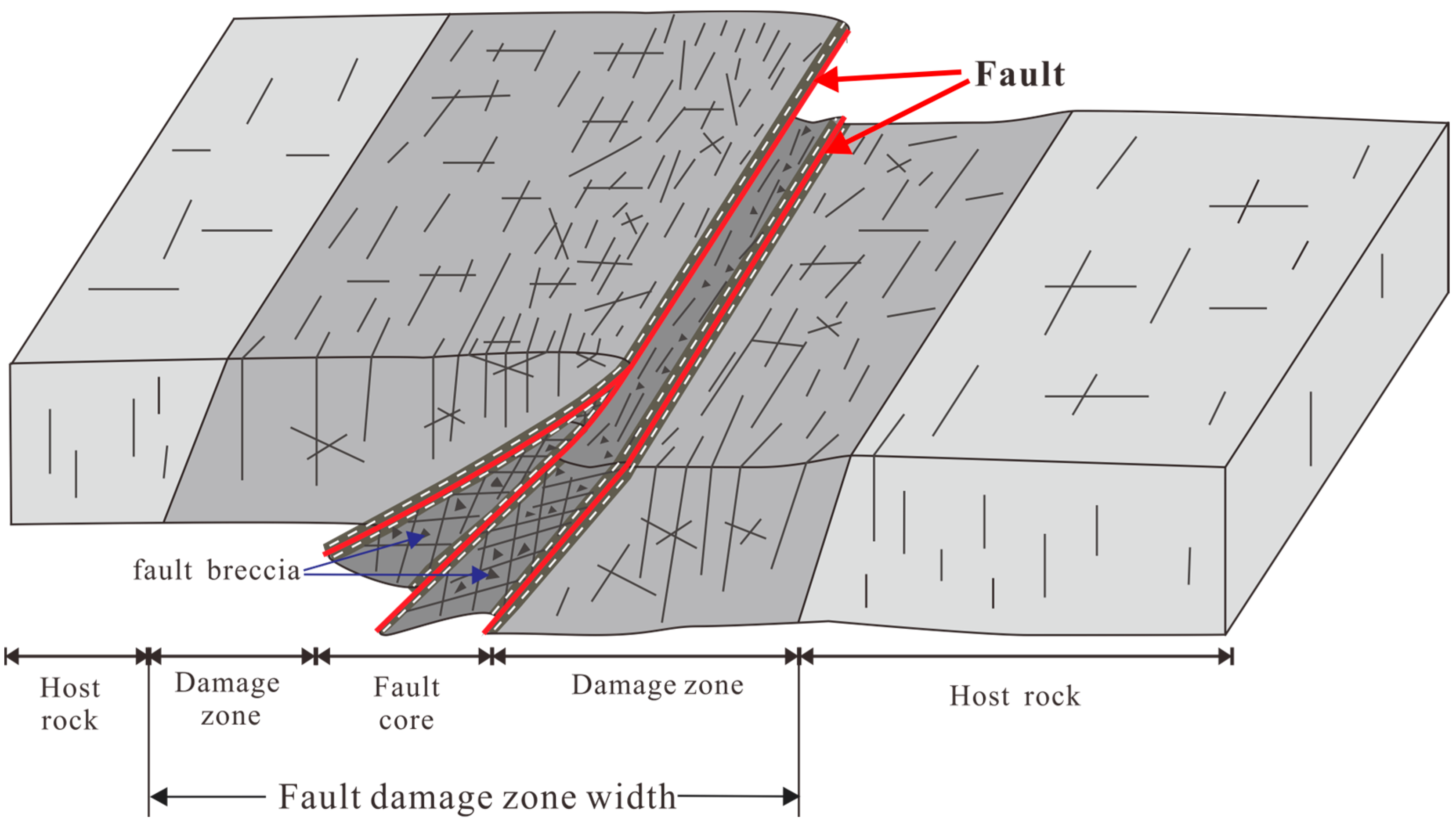
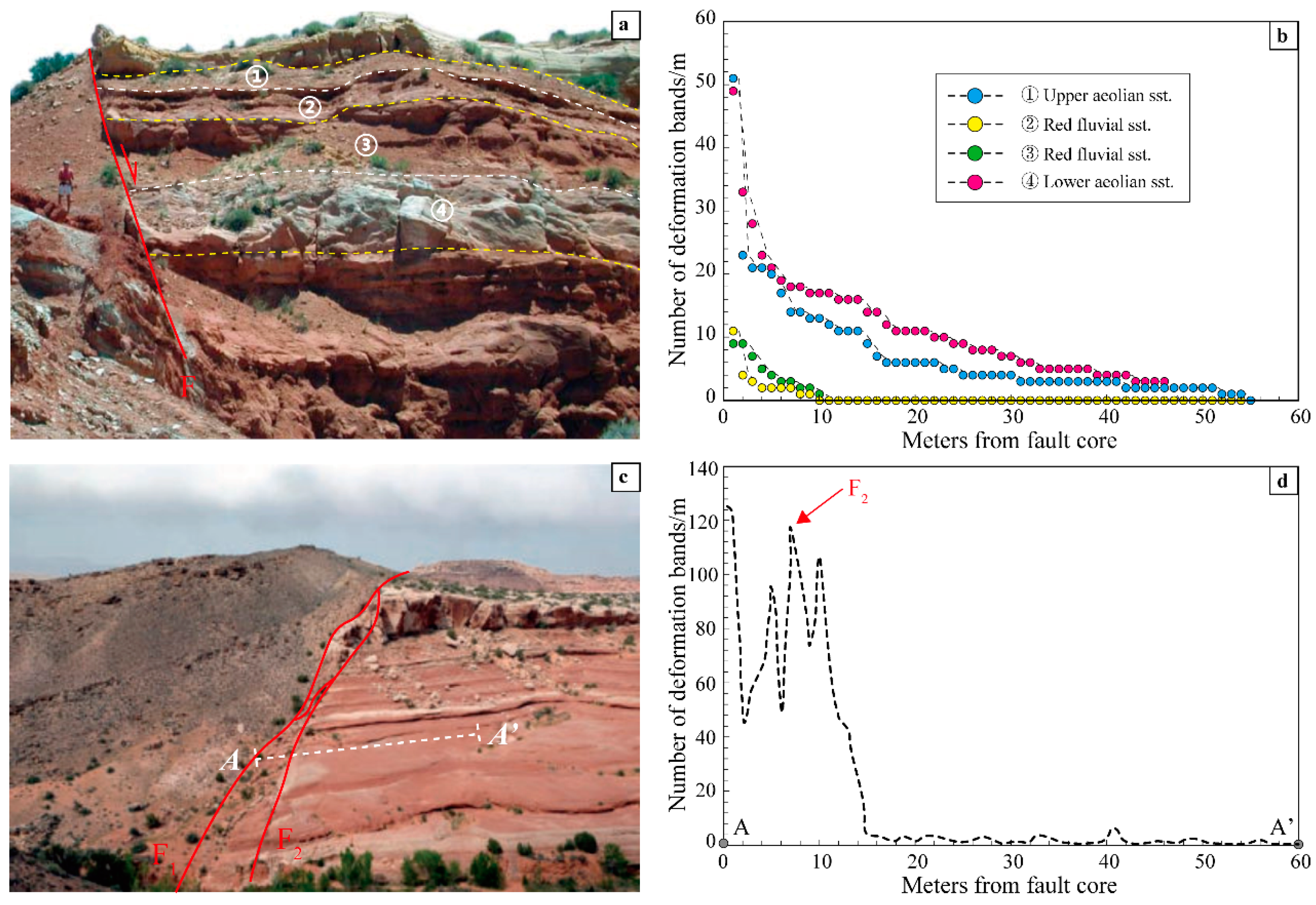
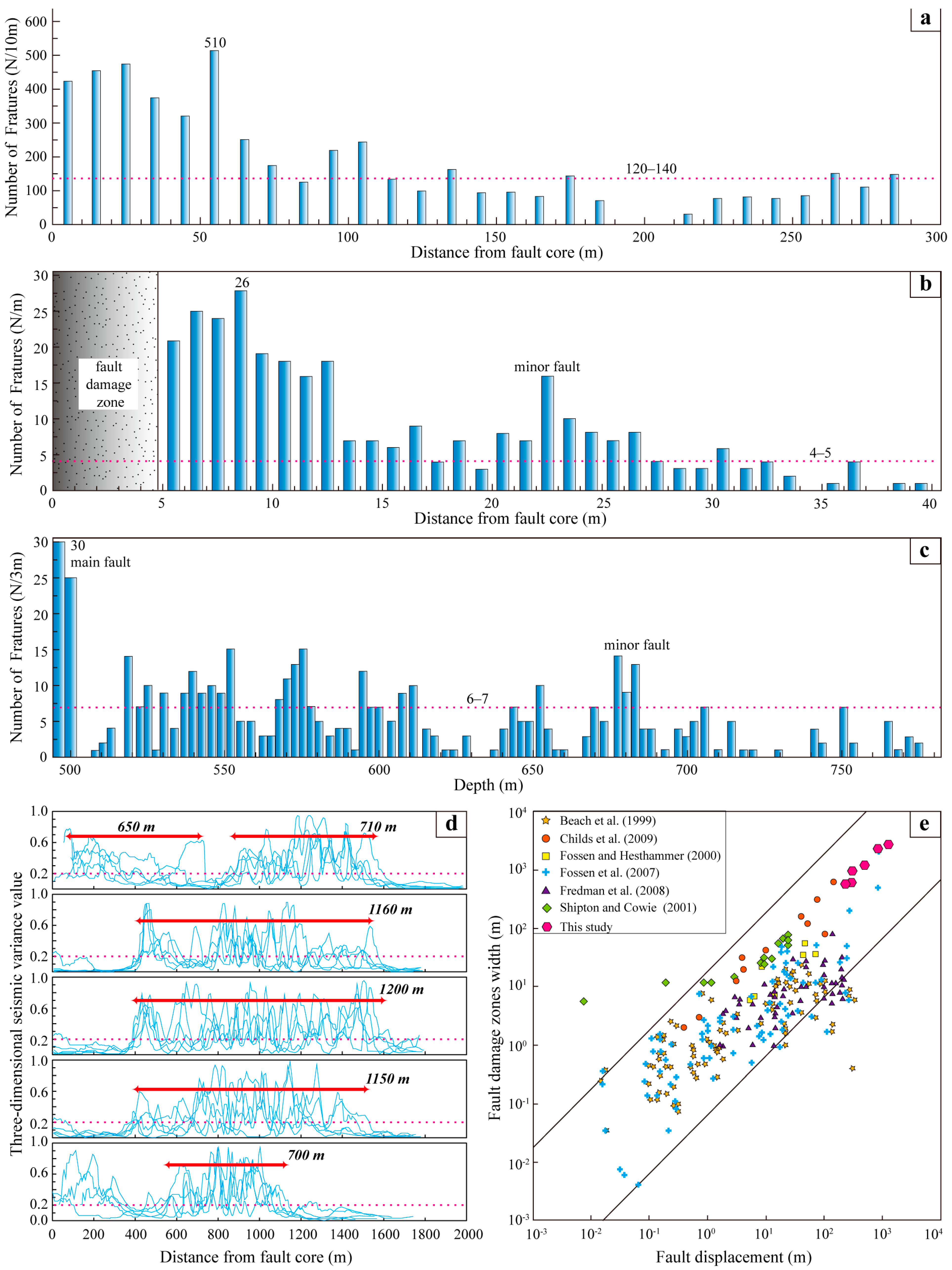
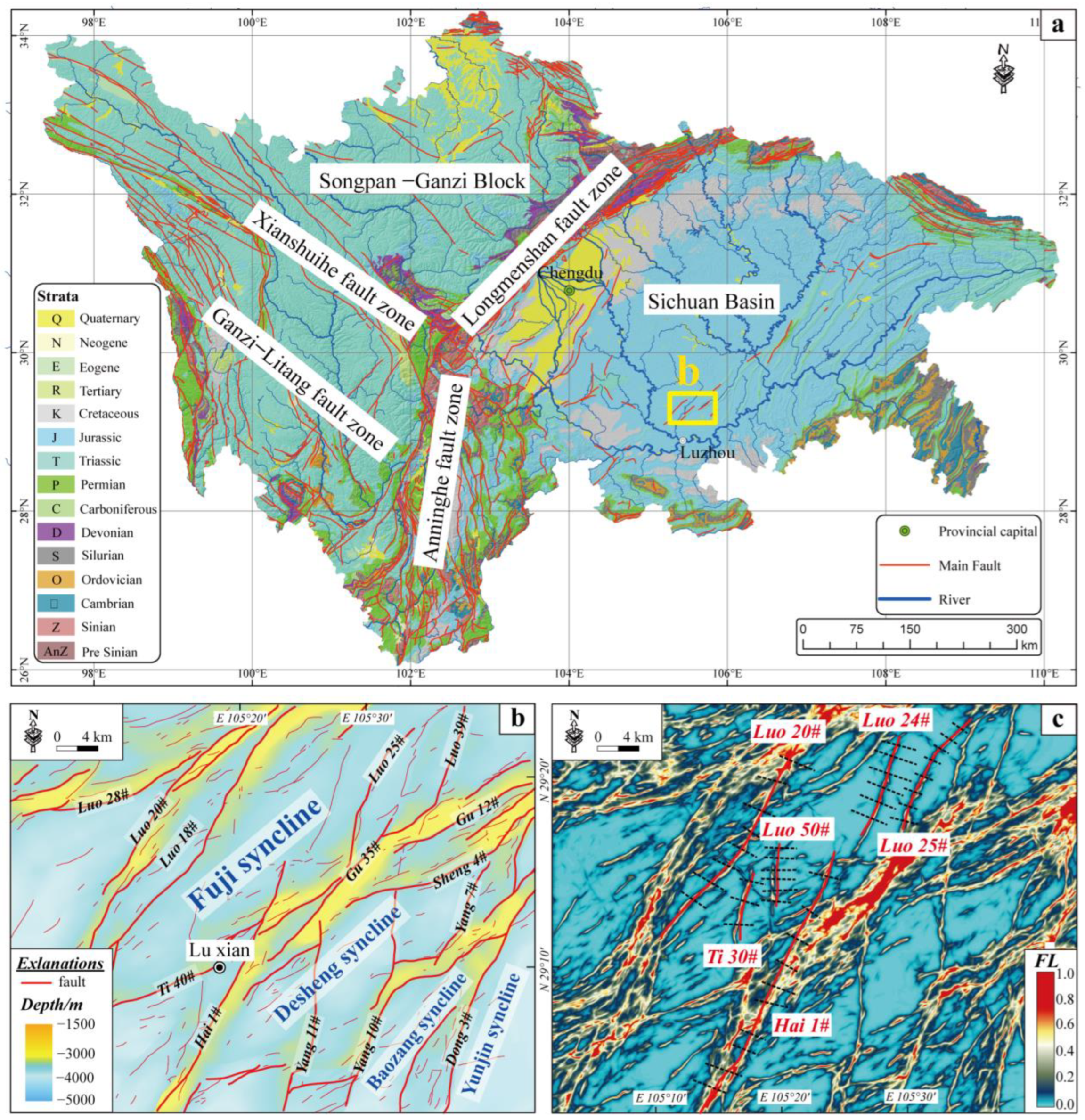
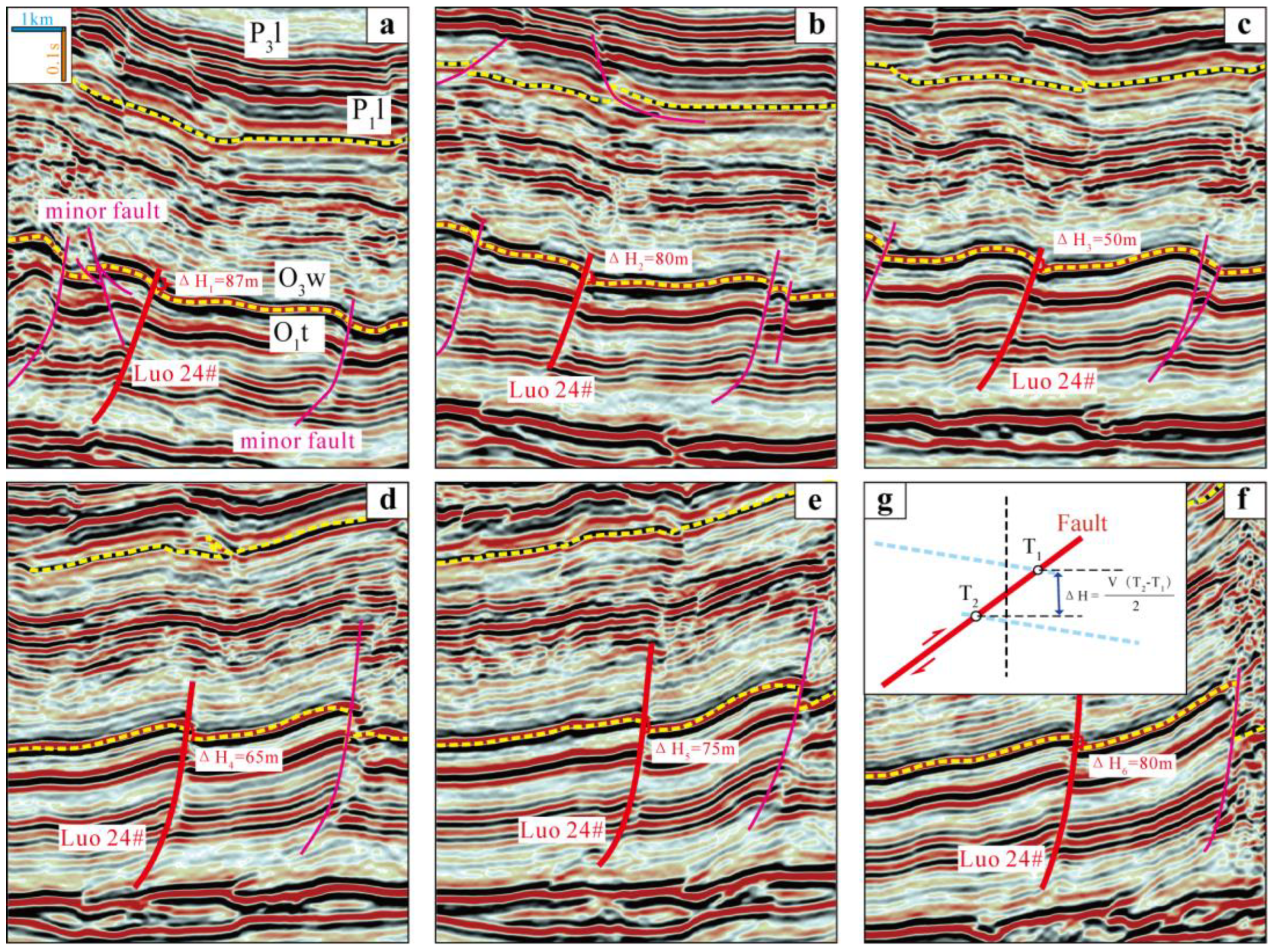

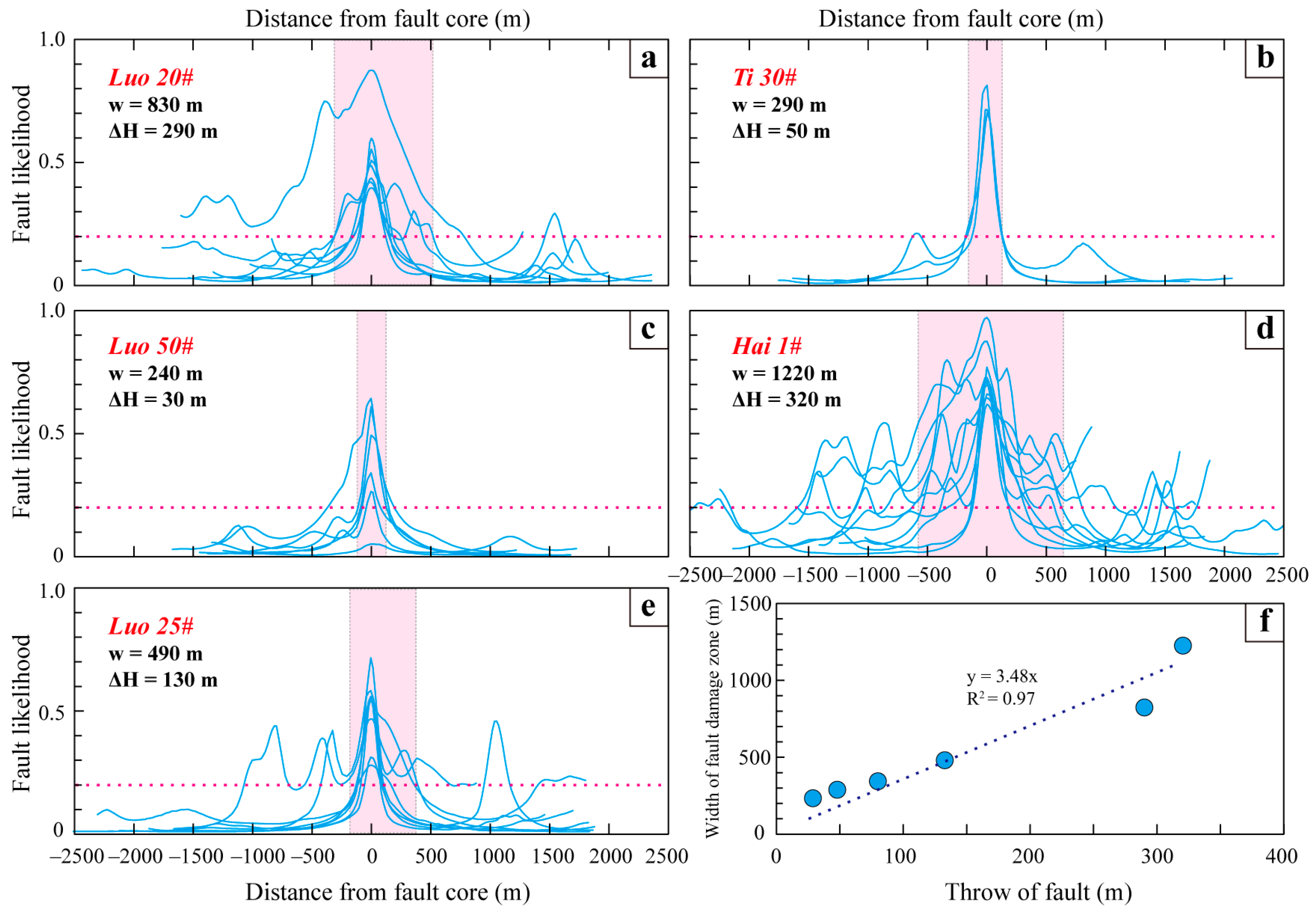
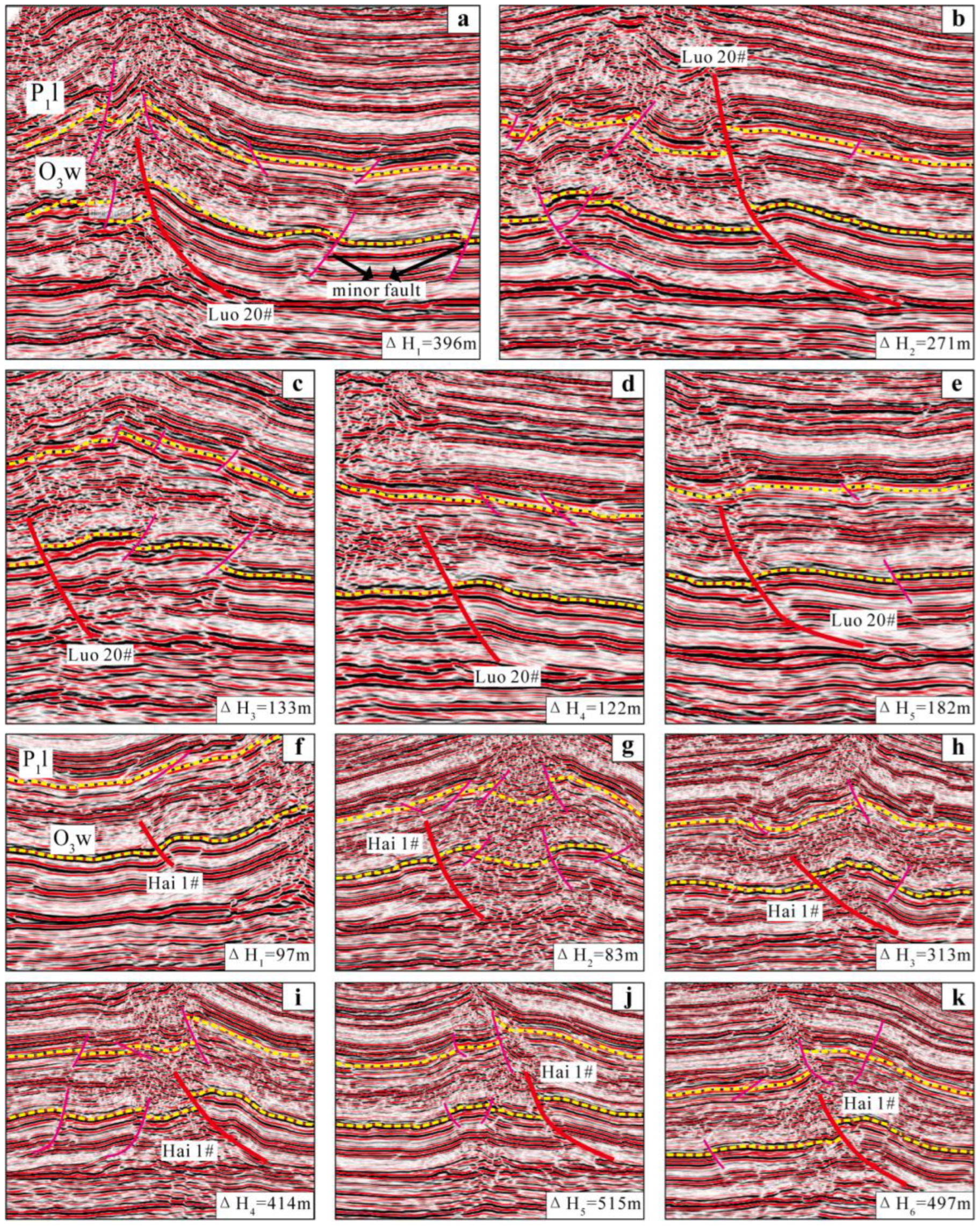
Disclaimer/Publisher’s Note: The statements, opinions and data contained in all publications are solely those of the individual author(s) and contributor(s) and not of MDPI and/or the editor(s). MDPI and/or the editor(s) disclaim responsibility for any injury to people or property resulting from any ideas, methods, instructions or products referred to in the content. |
© 2023 by the authors. Licensee MDPI, Basel, Switzerland. This article is an open access article distributed under the terms and conditions of the Creative Commons Attribution (CC BY) license (https://creativecommons.org/licenses/by/4.0/).
Share and Cite
Zeng, L.; Li, J.; Wu, S.; Tong, K.; Li, Z. Quantifying the Widths of Fault Damage Zones Based on the Fault Likelihood: A Case Study of Faults in the Fuji Syncline of the Luzhou Block, Sichuan Basin, China. Sustainability 2023, 15, 11771. https://doi.org/10.3390/su151511771
Zeng L, Li J, Wu S, Tong K, Li Z. Quantifying the Widths of Fault Damage Zones Based on the Fault Likelihood: A Case Study of Faults in the Fuji Syncline of the Luzhou Block, Sichuan Basin, China. Sustainability. 2023; 15(15):11771. https://doi.org/10.3390/su151511771
Chicago/Turabian StyleZeng, Lu, Jinxi Li, Shihu Wu, Kailin Tong, and Zhiwu Li. 2023. "Quantifying the Widths of Fault Damage Zones Based on the Fault Likelihood: A Case Study of Faults in the Fuji Syncline of the Luzhou Block, Sichuan Basin, China" Sustainability 15, no. 15: 11771. https://doi.org/10.3390/su151511771
APA StyleZeng, L., Li, J., Wu, S., Tong, K., & Li, Z. (2023). Quantifying the Widths of Fault Damage Zones Based on the Fault Likelihood: A Case Study of Faults in the Fuji Syncline of the Luzhou Block, Sichuan Basin, China. Sustainability, 15(15), 11771. https://doi.org/10.3390/su151511771






